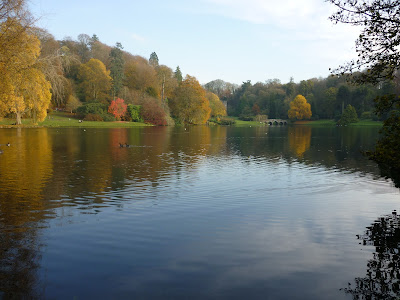Visiting Pompeii and Herculaneum was fascinating, but many of the paintings and mosaics, as well as other artifacts such as glass, silver, and household items have been removed, and are now in the
Museo Archeologico Natzionale in Naples, so I decided to take a day-trip into the city to visit the museum.
It's housed in an imposing building, (originally built as a university) and includes a vast
'Great Hall of The Sundial' which holds an ancient statue of Atlas, carrying the globe which is itself carved with depictions of the zodiac. (The sundial in question is set into the floor, and lit by a hole in one corner of the hall, and is, as far as I could make out, designed to show mid day at different seasons, rather than to measure the hours each day.
 |
| Alexander the Great - Mosaic from the 'House of the Faun', Pompeii (detail) |
Quite a few sections of the museum are closed, including, to my regret, the section holding the 'Farnese gems' (mainly cameos) and some of the Pompeii paintings, but I was able to see the mosaics from Pompeii, which are extraordinary. I think that the mosaic showing the battle between Alexander the Great, and King Darius is probably the most famous, and it is utterly amazing, but the others are pretty impressive, too.
 |
| Octopus vs. Lobster (detail of mosaic from the House of The Faun, Pompeii) |


I liked the seafood mosaic, and little details of several of the others - this spiky-toothed hippo, for example, and the cat, lurking below a birdbath.
There are also mosaic-decorated pillars, more cats, another guard-dog mosaic.

Another room worth visiting is the '
Gabinetto segreto' (secret room). This is not so much secret as segregated - it contains lots of erotic art - originally, in the early 19th Century, the room was closed, and only those who were "
of mature age and well known morality" were granted permits to view the "
infamous monuments of heathen licentiousness".

It was then open during the Garibaldi period, and closed under the fascist regime, until 1967! Now it is open again, although there is a sign outside in four or five languages warning it may not be suitable for younger visitors..

Some of the artworks, such as the
'Venus in a golden bikini' are quite unexceptional.

Others, however, such as the statue of Pan with a she-goat, are more startling, to modern eyes! There are also paintings taken from one of the
lupanares (brothels) in Pompeii, with paintings showing different acts and positions, and various Herms, votive offerings (how often do you see a cupboard entirely full of penises?) and paintings, mosaics and statues leaving nothing to the imagination!
After which it was quite soothing to go and look at charming, if at times confusing, paintings from Pompeii - a cupid with a pair of shoes, for instance.
 |
| Portrait of the baker, Terentius Neo, and his wife |
They also have selections of decorative silver, found at Pompeii (it survived intact having been stored in a chest, padded with blankets, possibly because the house was in the process of being reconstructed following the earthquake of 62AD. More amazingly, there are also glass items, and even papyrii which, despite the fact that they are seriously burned, archaeologists have succeeded in reading!


As well as the Pompeian art, there are also lots of sculptures, some of which were also found in Pompeii or Herculaneum
This lady -> is one of five statues found at Herculaneum, and still pristine.
One of the most famous sculptures in the museum is the '
Farnese Bull', which used to stand in Rome.

It is colossal.
And while I can't approve of celebrating the habit of tying ladies to enraged bulls, (even if they have been misbehaving) you have to admire the craftsmanship involved!

As you do with the other sculptures.
(the dog, incidentally, is part of a table leg. He is one of the 3-heads of a dog emerging from the stomach of the sea-monster, Scylla, attacking Ulysses' sailors. But you probably knew that.)
all in all, it's a fascinating museum, and I'm very glad that I had the time and opportunity to go.
























































